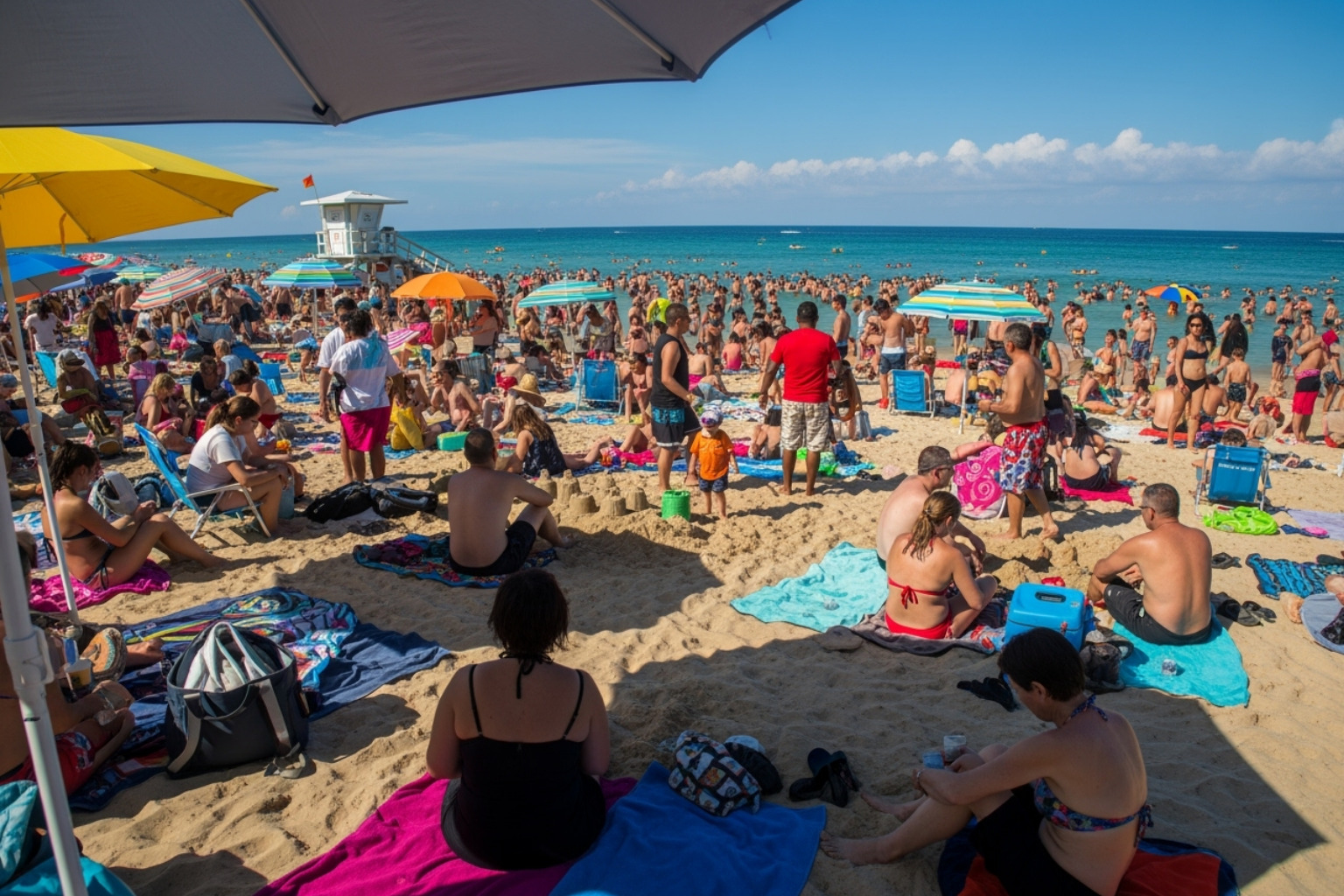A Shocking Price Tag on Paradise
Why are flights to Cabo so expensive? The answer lies in a perfect storm of high demand, limited airline capacity, luxury destination pricing, and seasonal travel patterns that drive up costs significantly compared to other Mexican beach destinations.
Quick Answer: The Main Reasons Flights to Cabo Cost So Much
- High Demand: Los Cabos is the most popular Mexican destination for Americans, creating intense competition for seats
- Limited Supply: Airlines have reduced nonstop flights and focused aircraft on larger hub cities
- Luxury Market: Cabo’s premium reputation allows airlines to charge higher fares
- Peak Season Premium: Winter and spring travel (December-April) sees average price increases of 6%
- Geographic Factors: Remote Baja California location requires longer flights and higher fuel costs
You’re not imagining it – that flight to paradise costs more than it should. Los Cabos has become Mexico’s most expensive destination, and airfare reflects this reality. While a round-trip flight from San Francisco might cost $818 or more, the same traveler could save $160 by flying from Tijuana instead.
The irony is striking: this stunning destination at the tip of the Baja California Peninsula offers some of Mexico’s most beautiful beaches and luxury resorts, but getting there has become a significant barrier for many families. What was once an affordable getaway has become a premium travel experience before you even step off the plane.
Understanding why flights cost so much – and knowing how to work around these challenges – can make the difference between a dream vacation and a budget-busting nightmare.
Why Are Flights to Cabo So Expensive?
If you’ve ever searched for flights to Los Cabos and felt your jaw drop at the prices, you’re definitely not alone. Why are flights to Cabo so expensive compared to other Mexican beach destinations? It’s not just one factor driving up those ticket prices – it’s a perfect storm of circumstances that all work together to make your dream vacation cost more than expected.
Imagine the most popular restaurant in town with only a few tables, serves premium food, and gets packed during the holidays. That’s essentially what’s happening with flights to this slice of paradise at the tip of the Baja California Peninsula.
It’s All About Supply, Demand, & the Calendar
The biggest culprit behind expensive Cabo flights? Timing is everything. Los Cabos has become the crown jewel of Mexican destinations for American travelers, and when everyone wants to go simultaneously, airlines know they can charge premium prices.
Peak season runs from December through April; during these months, you compete with thousands of other travelers trying to escape winter weather. We’re talking about families on winter break, college students planning Spring Break trips, and snowbirds heading south for months at a time. During peak periods like June, flight prices jump 6% higher than usual.
But here’s where it gets interesting – the calendar can work in your favor. September sees an average 7% drop in flight prices because most travelers avoid the hotter weather and potential hurricane season. You’ll deal with more heat and humidity, but your wallet will thank you.
If you’re planning, our Best Time to Visit Los Cabos in 2025: Weather & Events Guide breaks down exactly what to expect each month. And if you’re trying to avoid the Spring Break crowds (or join them!), check out When is Spring Break for Colleges? to plan accordingly.
Airline Economics: The Scarcity of Seats and Routes
Here’s where airline business decisions directly hit your travel budget. Airlines have been reducing the number of direct flights to Los Cabos, especially from California. A recent report shows that carriers are moving aircraft to focus on larger hub cities, creating a scarcity of nonstop seats.
When fewer direct flights are available, the remaining seats become incredibly valuable. Airlines know that travelers will pay extra to avoid long layovers and connection hassles. It’s basic economics—less supply with the same demand equals higher prices.
The airline’s home base also makes a huge difference. Mexican budget carriers can often offer significantly lower prices than US-based airlines because of their lower operating costs. For example, while you might pay $445 for a round-trip flight from San Diego on a US carrier, flying from Tijuana via Cross Border Xpress on a Mexican carrier could cost just $285—that’s a $160 savings for essentially the same destination.
This aircraft allocation strategy means that airlines prioritize routes that give them the highest profit margins, and unfortunately for travelers, that sometimes means fewer options for paradise.
The “Cabo Premium”: How a Luxury Destination Inflates Airfare
Los Cabos didn’t accidentally become expensive – it was a deliberate change from a simple fishing village to Mexico’s premier luxury destination. This rebranding has been incredibly successful but comes with a price tag that extends to your airline ticket.
The numbers tell the story. Los Cabos is now the most expensive destination in Mexico, with average hotel rates projected to hit around $560 per night by the end of 2025. That’s five times higher than Mexico City and double what you’d pay in Cancún or Puerto Vallarta. As reported in the Gringo Gazette, Los Cabos officially has the highest cost of living and hotel rates in all of Mexico.
This luxury destination status creates a cycle that keeps flight prices high. When airlines know that travelers plan to spend premium dollars on resorts, golf courses, and fine dining, they price their flights accordingly. The region’s 18 championship golf courses, world-class spas, and gourmet restaurants all contribute to an image that justifies higher airfares.
Even the logistics of running a luxury destination in a relatively remote location increase costs. Many goods need to be imported to the Baja California Peninsula, which increases operational expenses that eventually get passed on to travelers in various ways, including flight pricing.
The irony is that this premium positioning works exactly as intended – Los Cabos continues to see incredible growth in tourism, as detailed in our Los Cabos Tourism Growth 2025 analysis. The destination successfully attracts travelers willing to pay more for a premium experience, and airlines have adjusted their pricing strategies to match.
Understanding these factors is the first step in beating the system and finding better deals for your Los Cabos trip.
How to Fly Smarter and Save on Your Trip to Cabo
Now that we’ve explored why flights to Cabo are so expensive, let’s focus on the good news: there are proven strategies to beat these high prices. While you can’t change airline economics or Los Cabos’ popularity, you absolutely can outsmart the system with the right approach.
Secret Weapon:
Book between 45 to 90 days before departure for the best balance of price and availability. Planning a peak season trip during winter or spring? Start shopping even earlier – about 6 to 9 months ahead, especially for larger groups. Booking too early can backfire just like waiting too long, but this sweet spot gives you the best odds.
Flexibility:
With travel dates can open up incredible savings. Tuesday, Wednesday, and Saturday flights typically cost less and feel less chaotic than weekend departures. If you can avoid flying on Mondays and Fridays, your wallet will thank you. Even shifting your trip by a day or two can mean the difference between paying premium prices and snagging a deal.
Fare alerts:
These are like having a personal flight deal hunter working 24/7. Set up price notifications through major search engines, and you’ll get pinged the moment prices drop. This eliminates the exhausting routine of checking prices daily and ensures you won’t miss that perfect fare when it appears.
Flexible dates feature:
On flight search sites is pure gold if your schedule has some wiggle room. Viewing prices three days before or after your preferred dates often reveals cheaper alternatives hiding in plain sight. You might find that leaving on Thursday instead of Friday saves you $200 per person.
Hacker fares:
Combining one-way tickets from different airlines to create a cheaper round trip. While this requires more coordination, the savings can be substantial enough to justify the extra effort.
Leverage points and miles:
If you’re a frequent traveler or savvy credit card user, don’t forget your loyalty points. Transferring credit card points to airline partners or booking directly through a travel portal can sometimes slash the cash price of a flight to zero, leaving you with only taxes and fees. Given Cabo’s high fares, it can be an excellent destination to redeem points for maximum value.
For comprehensive flight search strategies and current deals, check out our detailed guide on Cabo Flights.
Thinking Outside the Box: Why are flights to Cabo so expensive from my city?
Sometimes the answer to high flight costs isn’t about when you fly, but where you fly from. If you’re in Southern California, there’s a brilliant workaround that can save you hundreds of dollars: the Cross Border Xpress (CBX) at Tijuana International Airport.
Here’s how this game-changing strategy works. Instead of flying directly from San Diego, you cross into Mexico and fly from Tijuana on Mexican carriers with much lower operating costs. The savings are dramatic – while a round-trip flight from San Diego might cost $445, the same trip from Tijuana could drop to just $285. That’s $160 in savings for about an hour of extra travel time.
The CBX is essentially a private pedestrian bridge connecting a terminal in San Diego directly to Tijuana’s airport. You buy a CBX crossing ticket (around $48 round-trip), park on the US side, walk across the enclosed bridge, clear Mexican immigration, and check in for your flight. It’s surprisingly smooth and adds an interesting international flavor to the start of your vacation.
Mexican budget carriers can offer these lower prices because they have significantly lower operational costs than US airlines. This translates directly to cheaper tickets for you. The process might sound complicated, but thousands of travelers use this route regularly. You can learn more about this innovative solution online.
| Departure City | Carrier (Example) | Round-Trip Fare (Example) | Total Cost (with CBX) | Savings (vs. SD) |
|---|---|---|---|---|
| San Diego | Alaska Airlines | $445 | N/A | N/A |
| Tijuana (CBX) | Volaris | $237 | $285 ($237 + $48 CBX) | $160 |
Your Arrival Plan: From Touchdown to a Stress-Free Welcome
Your vacation should begin seamlessly after successfully navigating the challenge of expensive flights and landing at Los Cabos International Airport (SJD). The last thing you want after a long journey is airport stress. Pre-booking your ground transportation is one of the smartest moves you can make, but knowing your options is important.
Upon exiting either Terminal 1 or Terminal 2, review your voucher and proceed to the corresponding umbrella number to meet your transportation representative. While you can try to book a transfer upon arrival, inventory may be limited or unavailable, so booking is highly recommended. We monitor all flight information you provide, so if your plane is delayed, we’ll adjust and be there when you land.
Private Transportation:
Our private transfer service offers a premium, personalized experience. A professional, bilingual driver will wait for each passenger, who will be served a complimentary cold beer or water. We can make a grocery stop on the way to your rental, and we provide child car seats upon request. Private transfers can take you directly to the front door of your destination, even inside private, gated communities. We serve the entire Los Cabos region, including San José del Cabo, Cabo San Lucas, Todos Santos, La Paz, and the East Cape.
Shared Shuttles:
For budget-conscious travelers, shared shuttles are an economic choice, typically costing between $13-$40 per person each way. Be prepared for a wait time of 15 minutes to an hour at the airport and an average of 2-4 stops en route to your hotel. To minimize travel time, we do our best to group passengers heading to similar areas. Please note that shared shuttles cannot make grocery stops, do not offer complimentary beverages, and are not permitted to enter private, gated communities (drop-off is at the main security gate). Child car seats are not allowed on shared shuttles, and every passenger, including infants, requires a purchased seat.
Booking and Cancellation:
We allow same-day reservations based on availability. If your plans change, you can cancel up to 72 hours before your service for a full refund, subject to a $5 USD processing fee, by using our online cancellation link or calling our office.
For detailed guidance on navigating the airport efficiently, read our comprehensive guide on Cabo Airport Transportation and learn how to Avoid Long Lines at Cabo Airport. Ready to secure your hassle-free arrival? Book your private transportation with us today.




